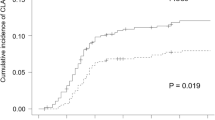Abstract
Central venous catheter-related blood stream infections (CR-BSIs) are a serious complication in patients with hematological malignancies. However, it remains unclear whether there is a difference in the rate of CR-BSI associated with the conventional type of central venous catheters (cCVCs) and peripherally inserted CVCs (PICCs) in such patients. To address this question, we retrospectively investigated the incidence of CR-BSIs associated with PICCs versus cCVCs in patients with hematological malignancies. We used PICCs in all consecutive patients requiring CVC placement between February 2009 and February 2013. We compared the CR-BSI rate in patients with PICCs with that in patients with cCVCs treated between September 2006 and January 2009 (control group). Eighty-four patients received PICCs and 85 received cCVCs. The most common reason for removal due to catheter-related complications was CR-BSI. The CR-BSI rate in the PICC group was significantly lower than that in the cCVC group (PICCs: 1.23/1000 catheter days; cCVCs: 5.30/1000 catheter days; P < 0.01). Catheter-related complications other than CR-BSIs occurred at an extremely low rate in the PICC group. The median catheter-related complication-free survival duration was significantly longer in the PICC group than in the cCVC group. Our study shows that PICCs are useful in patients with hematological malignancies.


Similar content being viewed by others
References
Hoshal VL Jr. Total intravenous nutrition with peripherally inserted silicone elastomer central venous catheters. Arch Surg. 1975;110:644–6.
Gunst M, Matsushima K, Vanek S, Gunst R, Shafi S, Frankel H. Peripherally inserted central catheters may lower the incidence of catheter-related blood stream infections in patients in surgical intensive care units. Surg Infect (Larchmt). 2011;12:279–82.
Moureau N, Poole S, Murdock MA, Gray SM, Semba CP. Central venous catheters in home infusion care: outcomes analysis in 50470 patients. J Vasc Interv Radiol. 2002;13:1009–16.
Worth LJ, Seymour JF, Slavin MA. Infective and thrombotic complications of central venous catheters in patients with hematological malignancy: prospective evaluation of nontunneled devices. Support Care Cancer. 2009;17:811–8.
Bellsei S, Chiusolo P, De Pascale G, Pittiruti M, ScoppettuoloG,Metafuni E et al. Peripherally inserted central catheters (PICCs) in the management of oncohematological patients submitted to autologous stem cell transplantation. Support Care Cancer. 2013;21:531–5.
Mollee P, Jones M, Stackelroth J, van Kuilenburg R, Joubert W, Faoagali J, et al. Catheter-associated bloodstream infection incidence and risk factors in adults with cancer: a prospective cohort study. J Hosp Infect. 2011;78:26–30.
Lim MY, Al-Kali A, Ashrani AA, Begna KH, Elliott MA, Hogan WJ, et al. Comparison of complication rates of Hickman catheters versus peripherally inserted central catheters in patients with acute myeloid leukemia undergoing induction chemotherapy. Leuk Lymphoma. 2013;54:1263–7.
Mermel Leonard A, Allon Michael, Bouza Emilio, Craven Donald E, Flynn Patricia, O’Grady Naomi P, et al. Clinical Practice Guidelines for the Diagnosis and Management of Intravascular Catheter-Related Infection: 2009 Update by the Infectious Diseases Society of America. Clin Infect Dis. 2009;49:1–45.
O’Grady NP, Alexander M, Dellinger EP, Gerberding JL, Heard SO, Maki DG, et al. Guidelines for the prevention of intravascular catheter-related infections. Infect Control Hosp Epidemiol. 2002;23:759–69.
Bottino J, McCredie KB, Groschel DH, Lawson M. Long-term intravenous therapy with peripherally inserted silicone elastomer central venous catheters in patients with malignant diseases. Cancer. 1979;43:1937–43.
Skiest DJ, Abbott M, Keiser P. Peripherally inserted central catheters in patients with AIDS are associated with a low infection rate. Clin Infect Dis. 2000;30:949–52.
Roth RR, James WD. Microbial ecology of the skin. Annu Rev Microbiol. 1988;42:441–64.
Noble WC. Skin microbiology: coming of age. J Med Microbiol. 1984;17:1–12.
Safdar N, Maki DG. Risk of catheter-related bloodstream infection with peripherally inserted central venous catheters used in hospitalized patients. Chest. 2005;128:489–95.
Cowl CT, Weinstock JV, Al-Jurf A, Ephgrave K, Murray JA, Dillon K. Complications and cost associated with parenteral nutrition delivered to hospitalized patients through either subclavian or peripherally-inserted central catheters. Clin Nutr. 2000;19:237–43.
Tomlinson D, Mermel LA, Ethier MC, Matlow A, Gillmeister B, Sung L. Defining bloodstream infections related to central venous catheters in patients with cancer: a systematic review. Clin Infect Dis. 2011;53:697–710.
Allen AW, Megargell JL, Brown DB, Lynch FC, Singh H, Singh Y, et al. Venous thrombosis associated with the placement of peripherally inserted central catheters. J Vasc Interv Radiol. 2000;11:1309–14.
Skaff ER, Doucette S, McDiarmid S, Huebsch L, Sabloff M. Vascular access devices in leukemia: a retrospective review amongst patients treated at the Ottawa Hospital with induction chemotherapy for acute leukemia. Leuk Lymphoma. 2012;53:1090–5.
Hatakeyama N, Hori T, Yamamoto M, Mizue N, Inazawa N, Igarashi K, et al. An evaluation of peripherally inserted central venous catheters for children with cancer requiring long-term venous access. Int J Hematol. 2011;94:372–7.
Abedin S, Kapoor G. Peripherally inserted central venous catheters are a good option for prolonged venous access in children with cancer. Pediatr Blood Cancer. 2008;51:251–5.
Chaberny IF, Ruseva E, Sohr D, Buchholz S, Ganser A, Mattner F, et al. Surveillance with successful reduction of central line-associated bloodstream infections among neutropenic patients with hematologic or oncologic malignancies. Ann Hematol. 2009;88:907–12.
Conflict of interest
The authors declare that they have no conflict of interest.
Author information
Authors and Affiliations
Corresponding author
About this article
Cite this article
Sakai, T., Kohda, K., Konuma, Y. et al. A role for peripherally inserted central venous catheters in the prevention of catheter-related blood stream infections in patients with hematological malignancies. Int J Hematol 100, 592–598 (2014). https://doi.org/10.1007/s12185-014-1677-9
Received:
Revised:
Accepted:
Published:
Issue Date:
DOI: https://doi.org/10.1007/s12185-014-1677-9



